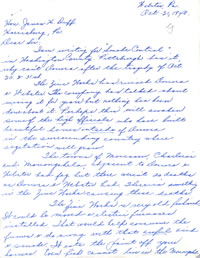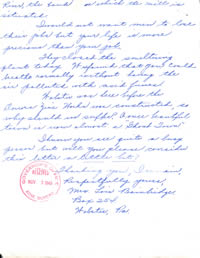The Donora Smog Disaster - October 30-31, 1948
Images
Click images for larger versions.
History
Manuscript Group 190: James H. Duff Papers, Subject File, Letter of Mrs. Lois Bainbridge of Webster, PA, to the Governor, October 31, 1948. One page, fountain pen ink on paper.
On October 30 and 31, 1948, atmospheric conditions in the vicinity of Donora, Pennsylvania, contributed to the deaths of nineteen people within a 24-hour period. Of the fatalities, two had active pulmonary tuberculosis. The other seventeen were known to have had chronic heart disease or asthma. All were between 52 and 85 years of age. In addition, approximately five hundred residents of the area became ill, reporting symptoms of respiratory problems. No doubt, countless others suffered in silence.
Donora is located on the western bank of the Monongahela River in Washington County. During the late Colonial period (1760s and 1770s), the area was known as "Horseshoe Bottom, because there the river curved into that shape. Nearby hills rise approximately 400 feet above the river's surface, and their peaks are approximately one mile apart. Early settlers grew grain in the fertile valley which led two of them to build a grain mill and lay out streets around it. By 1815, the village, then known as Columbia, contained twenty houses. In 1819, the postal authorities changed the name to West Columbia. Other small communities developed in the area including Bisselltown, Sunnyside, Bakertown, and Webster, which emerged on the other side of the river. These places remained little more than villages throughout the nineteenth century.
Modern Donora began in 1900 with the development of heavy industry in the area. The town was incorporated in 1901. Its name is a combination of Nora Mellon, wife of R. B. Mellon, and W. H. Donner, the purchasers of the land along the river on which their Union Steel Company constructed a rod mill that later became the American Steel and Wire Works. In 1902, the Carnegie Steel Company completed a facility that consisted of two blast furnaces, twelve open hearth furnaces, and a forty foot blooming mill furnace. At the same time, the Matthew Woven Wire Fence Company erected a facility. A third rod mill was constructed in 1916. A year earlier the Donora Zinc Works began production. Such industrial expansion required more effective transportation facilities than the river barges and short-line railroads could provide. The Pennsylvania Railroad bought what had been the Monongahela Valley Company and expanded rail service. By 1908, the Donora station had the largest volume of freight in the "Mon Valley." Of course, these industries needed workers, and job-seekers flocked to the area, especially recently arrived immigrants. In 1948, 14,000 people resided in Donora, and additional thousands lived in towns in the immediate vicinity.
The causes of the incident are difficult to identify conclusively, nevertheless, there are several obvious possibilities. Residents, such as Mrs. Lois Bainbridge, who wrote to Governor James T. Duff about the situation, stated that people in the area had complained for years abut the industrial pollutants that "eats the paint off your houses" and prevents fish from living in the river. Indeed, an investigation supervised by the director of the state government's Bureau of Industrial Hygiene revealed an extraordinarily high level of sulfur dioxide, soluble sulphants, and fluorides in the air on October 30 and 31. According to the agency's report and complaints by residents, such contamination of the atmosphere was caused by the zinc smelting plant, steel mills' open hearth furnaces, a sulphuric acid plant, with slag dumps, coal burning steam locomotives, and river boats also contributing to the problem. An unusually dense fog, the likes of which even long-time residents could not remember, may have been held in the valley by the surrounding hills. The fog probably kept the pollutants close to the earth's surface where the residents inhaled them.
Solutions to the problem were obvious. Mrs. Bainbridge charged that the zinc company officials "for years" had discussed moving the plant; however, they did not do it. As her letter indicates, she was certain that "there is something in the Zinc Works causing these deaths." She observed that when the "smelting plant" closed briefly after the crisis, "you could breathe normally...." She proposed also the installation of more modern equipment that "would help consume the fumes." Because the plants' owners had not acted to eliminate the pollutants, she proposed Washington County "Smoke Control" laws similar to those that were enacted in Pittsburgh a few years earlier.
Such solutions were difficult to implement. Moving or closing the offending industries could cost workers their jobs, as Mrs. Bainbridge acknowledged. Nevertheless, to her, men's jobs were less important than people's lives. The acquisition of new equipment and the use of new procedures could be costly which would affect adversely the profitability and practicality of manufacturing the product. Politicians were aware of the complexity of these issues and were reluctant to legislate on them.
The Donora Smog Disaster attracted attention to this problem. Although smog's effect on the people in and around Donora on October 30 and 31, 1948 was extreme, residents of other communities also suffered from environmental contaminants. Consequently in 1949, the state government established the Division of Air Pollution Control to study the matter. Eventually, members of Pennsylvania's General Assembly felt the pressure to cleanse Pennsylvania's atmosphere of harmful substances. Consequently, the legislature passed the clean streams law in 1965 and began to enact state wide clean air regulations in 1966. In 1970, the legislature passed an "Environmental Bill of Rights" which stated that "the people have a right to clean air, [and] pure water...." Simultaneously, the national government established the Environmental Protection Agency, and Congress passed the Clean Air Act. A few years later, Pennsylvania established the Department of Environmental Resources, one of the prominent objectives of which was "to ensure future generations of Commonwealth residents a quality environment." This function is carried on today by the Department of Environmental Protection. It might be noted too that many of the contaminating industries have left the state and some have left the nation. Whether there is a "cause and effect" relationship between environmental legislation and the loss of heavy industry is not clear.
Transcript
(spelling and usage retained from original document)
Webster, Pa
October 31, 1948
Hon. James H. Duff
Harrisburg, Pa
Dear Sir,
I am writing for "Smoke Control" in Washington County. Pittsburgh has it, why can't Donora after the tragedy of October 30 and 31st.
The Zinc Works has ruined Donora and Webster. The company has talked about moving it for years but nothing has been done about it. Perhaps this will awaken some of the high officials who have built beautiful homes outside of Donora in the surrounding country where vegetation will grow.
The towns of Monessen, Charleroi and Monongahela adjacent to Donora and Webster had fog, but there weren't 20 deaths as Donora and Webster had. There is something in the Zinc Works causing these deaths.
The Zinc Works is very old fashioned. It could be moved and electric furnaces installed. That would help consume the fumes and do away with the awful acid and smoke. It eats the paint off your houses. Even fish can't live in the Monongahela River, the bank on which the mill is situated.
I would not want men to lose their jobs, but your life is more precious than your job.
They closed the smelting plant today. Was found that you could breathe normally without having the air polluted with acid fumes.
Webster was here before the Donora Zinc Works was constructed, so why should we suffer? A beautiful town is now almost a "ghost town."
I know you are quite a busy person, but will you please consider this letter just a little bit?
Thanking you, I am respectfully Yours,
Mrs. Lois Bainbridge
Box 254
Webster, Pa.

